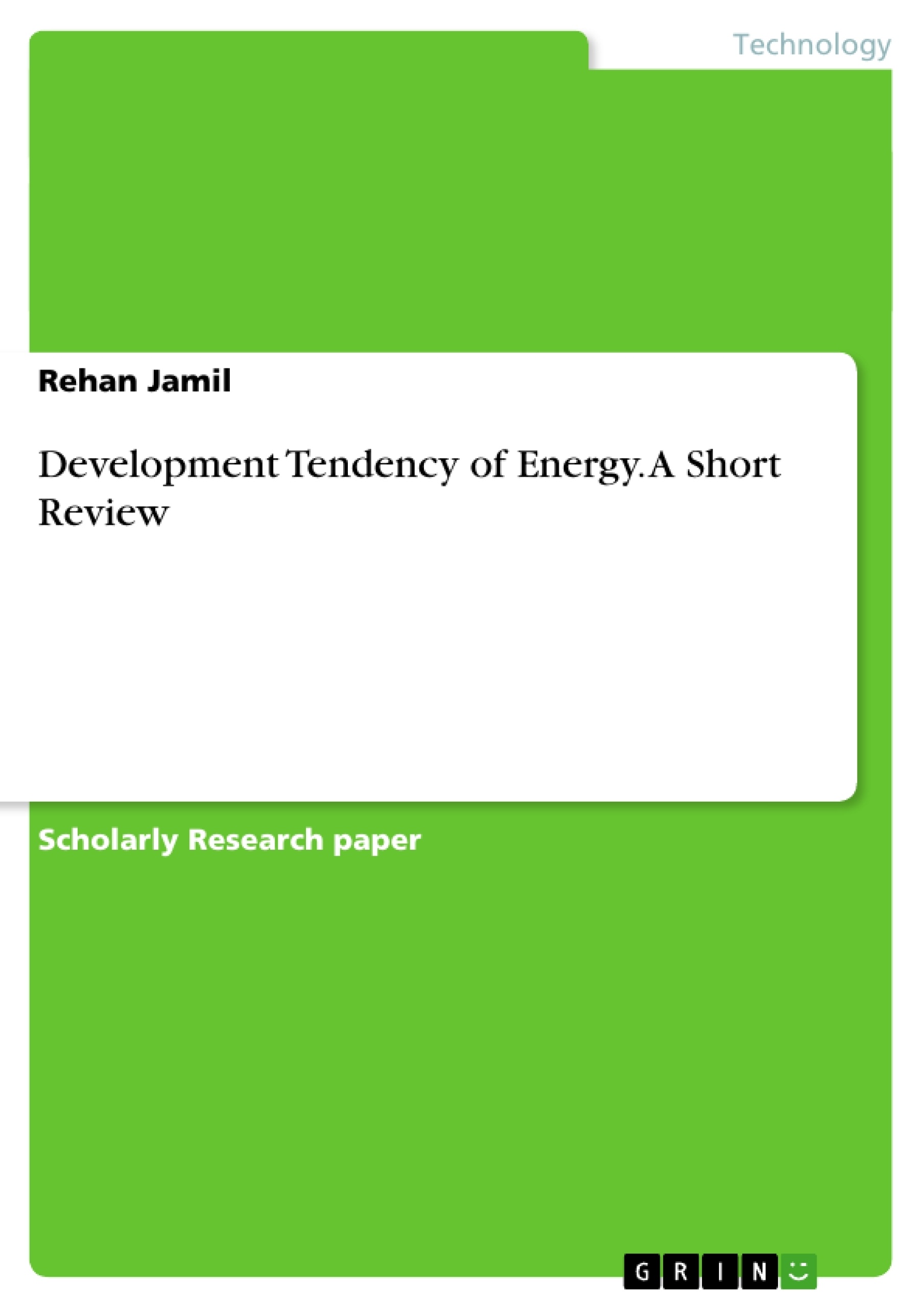Energy is the important source for the development of the society and it‘s the basic support of national economy and the base for human living. As the development of economy, abrupt increase of population and continuous improvement of living standards, the demand of energy increases continuously, which caused the impetuous scramble of energy source in the world, and urged the attention of the countries for current status and development trends of energy.
Inhaltsverzeichnis (Table of Contents)
- I. INTRODUCTION
- II. ANALYSIS OF ENERGY SUPPLY SITUATION
- A. Petroleum
- B. Natural Gas
- C. Coal
- D. Nuclear Power
- E. Renewable Energy
- III. STATUS QUO AND CHARACTERISTICS OF GLOBAL ENERGY CONSUMPTION
- A. Influenced of Economy Development and Population Increase, Primary Energy Consumption Amount up Continuously
- B. Global Energy Consumption Presents Different Growth Modes; the Growth Rate of Developed Countries Is Obviously Lower than That of Developing Countries
- C. Main reason
- D. Global Energy Consumption Structure Tends to Optimize, While Regional Difference Is Obvious
- E. Main Reason Global Energy Consumption Structure Tends to Optimize, While Regional Difference Is Obvious
- IV. ANALYSIS OF THE TREND OF ENERGY SUPPLY AND DEMAND IN THE WORLD
- V.CONCLUSION
Zielsetzung und Themenschwerpunkte (Objectives and Key Themes)
This paper provides a short review of the development tendency of energy consumption in the world. The paper discusses key trends and challenges in energy supply and demand, particularly the increasing energy consumption driven by global economic expansion and population growth. The work emphasizes the need for a diversified, clean, and efficient energy mix to address these challenges, while also highlighting the globalization and marketization of the energy sector.- Energy Supply and Demand Dynamics
- Global Energy Consumption Trends
- Energy Security and Resource Scarcity
- Sustainable Energy Development and Environmental Concerns
- Globalization and Marketization of the Energy Sector
Zusammenfassung der Kapitel (Chapter Summaries)
- I. INTRODUCTION: The chapter presents a global overview of energy consumption trends, highlighting significant increases in energy demand across various regions, particularly in Asia-Pacific. It notes exceptions, like a decrease in energy consumption in Japan and the European Union.
- II. ANALYSIS OF ENERGY SUPPLY SITUATION: This chapter examines the supply situation of different energy sources:
- A. Petroleum: Reviews global petroleum consumption, production, and trade trends, noting increasing demand in emerging economies and a decline in production by OPEC.
- B. Natural Gas: Discusses the reserves, consumption, and production of natural gas worldwide. It highlights a significant increase in natural gas consumption, particularly in China and North America.
- C. Coal: Analyzes global coal consumption and production trends, pointing out the continued dominance of coal in the energy mix and its rapid growth, particularly in China and India.
- D. Nuclear Power: Examines the production and consumption of nuclear power, highlighting the decline in nuclear energy use, especially in Germany and Japan.
- E. Renewable Energy: Explores the growth of renewable energy sources, particularly ethanol, wind energy, and solar energy, emphasizing their increasing contribution to the global energy mix.
- III. STATUS QUO AND CHARACTERISTICS OF GLOBAL ENERGY CONSUMPTION: This chapter delves into the factors influencing global energy consumption patterns:
- A. Influenced of Economy Development and Population Increase, Primary Energy Consumption Amount up Continuously: Examines the correlation between economic growth, population increase, and energy consumption, showcasing the continuous rise in primary energy consumption globally.
- B. Global Energy Consumption Presents Different Growth Modes; the Growth Rate of Developed Countries Is Obviously Lower than That of Developing Countries: Analyzes the different growth rates of energy consumption in developed and developing countries, highlighting the slower growth in developed economies due to factors like post-industrialization and energy conservation.
- C. Main reason: Discusses the key reasons behind the different growth rates of energy consumption in developed and developing countries, emphasizing economic transitions, energy conservation efforts, and structural changes.
- D. Global Energy Consumption Structure Tends to Optimize, While Regional Difference Is Obvious: Explores the evolution of the global energy consumption structure, highlighting the shift towards a more diverse mix of energy sources, with fossil fuels still dominating, but renewable energy sources becoming increasingly significant.
- E. Main Reason Global Energy Consumption Structure Tends to Optimize, While Regional Difference Is Obvious: Examines the factors driving the shift towards a more optimized energy consumption structure, emphasizing the depletion of resources in some regions, the rise of energy trading, and the growing importance of energy transportation and security.
- IV. ANALYSIS OF THE TREND OF ENERGY SUPPLY AND DEMAND IN THE WORLD: This chapter presents forecasts for future energy supply and demand trends, highlighting the anticipated increase in energy demand, particularly in emerging economies, and the increasing pressure on energy resources. The chapter also discusses the challenges associated with securing energy supply and the need for diversification, clean energy production, and energy efficiency improvements.
Schlüsselwörter (Keywords)
This paper focuses on global energy consumption patterns, supply and demand dynamics, resource scarcity, energy security, sustainable energy development, environmental challenges, globalization, and energy market trends. The paper also explores different energy sources, including fossil fuels, renewable energy, and nuclear energy. The work uses terms such as energy intensity, oil equivalent, and renewable energy to analyze these trends and challenges.
Ende der Leseprobe aus 6 Seiten
- nach oben
- Arbeit zitieren
- Rehan Jamil (Autor:in), 2013, Development Tendency of Energy. A Short Review, München, GRIN Verlag, https://www.grin.com/document/267964
Blick ins Buch



